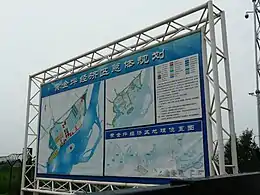 | |
| Geography | |
|---|---|
| Location | Yalu River |
| Coordinates | 39°58′N 124°19′E / 39.96°N 124.31°E |
| Area | 11.45 km2 (4.42 sq mi) |
| Administration | |
| Province | North P'yŏngan |
| County | Sindo County |
| Demographics | |
| Ethnic groups | Koreans |
Hwanggumpyong (Korean: 황금평, simplified Chinese: 黄金坪; traditional Chinese: 黃金坪; pinyin: Huángjīnpíng), formerly called Hwanggumpyong Island (Korean: 황금평도, simplified Chinese: 黄金坪岛; traditional Chinese: 黃金坪島; pinyin: Huángjīnpíng Dǎo), is a North Korean free-trade area bordering China. The area used to be a tidal island in the Yalu River. However, due to continuous deposition of river-borne sediments, the northern portion of the former island is now permanently connected with the Chinese city of Dandong. A steel mesh fence has been built to mark the land border between North Korea and China.[1]
Due to ethnic Koreans living on the island at the time of a 1962 border treaty, both China and North Korea agreed that the sovereignty of the island belongs to North Korea. The former river island is now a North Korean exclave on the otherwise Chinese side of the river.[2]
History
In June 2011, an agreement, negotiated by Gao Jingde, of Sunbase International Holdings Ltd,[3] with China was made to establish a joint free-trade area on Hwanggumpyong and Wihwa Islands, as well as the Chinese border area near Dandong.[4] By 2013, the site had been prepared, and a free-trade area of over 300 acres (120 ha) may be ready for operation in about two years.[5]
As of 2019, the free-trade area has not been very successful.[6]
References
- ↑ 韩媒体称朝鲜将两个岛租给中国 拟打造朝版香港 (in Chinese)
- ↑ Jeong Woo-sang (10 June 2011). "What Is Hwanggumpyong Island?". Digital Chosun. Retrieved 1 March 2012.
- ↑ Kim, Young-gyo (20 June 2011). "Hong Kong conglomerate likely to be tapped as developer of N. Korean island: report". Yonhap News Agency.
- ↑ Robert Kelley; Michael Zagurek; Bradley O. Babson (19 February 2012). "PRC's Embrace of North Korea: The Curious Case of the Hwanggumpyong Island Economic Zone". 38 North. U.S.-Korea Institute, Johns Hopkins University School of Advanced International Studies. Retrieved 1 March 2012.
- ↑ Nick Hansen; Jeffrey Lewis (17 June 2013). "New Construction Activity at the Hwanggumpyong Economic Zone". 38 North. U.S.-Korea Institute, Johns Hopkins University School of Advanced International Studies. Retrieved 22 June 2013.
- ↑ Clément, Théo (29 October 2019). "Failed Attempts at Cross-Border Economic Integration: The View from Dandong". 38 North. The Henry L. Stimson Center. Retrieved 8 November 2019.